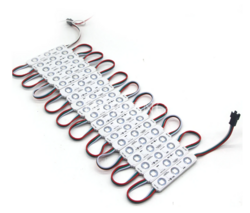In the past decade, the way we illuminate our surroundings has changed dramatically. LEDs, once considered a niche solution, have become a central component in residential, commercial, and industrial lighting strategies. The growing demand for energy-efficient, low-maintenance lighting has opened the door for more versatile solutions like LED strip lights and modules both of which are shaping how lighting is designed and installed across industries.
As we explore this evolving landscape, it’s clear that the need for adaptable and durable lighting goes well beyond aesthetics. These lighting systems are now essential in signage, architectural highlights, retail displays, and even in complex installations that require high levels of precision.
The Flexible World of LED Strip Lights
LED strip lights are often favored for their simplicity and flexibility. Designed as slim, adhesive-backed tapes filled with tiny light-emitting diodes, they offer creative freedom to architects, designers, and engineers alike. Their adaptability makes them ideal for curved edges, under-cabinet lighting, ceiling designs, and display shelves.
Beyond their physical flexibility, strip lights allow for nuanced control of brightness, color temperature, and beam angle. With advancements in dimming systems and RGB configurations, users now have the option to design ambient or task lighting tailored to specific environments. Whether you’re working with a retail layout or an office refurbishment, strip lighting can deliver both form and function.
Key Considerations When Exploring LED Strip Lights Suppliers
When choosing LED Strip Lights suppliers, it’s essential to look beyond just pricing. Quality and consistency are two crucial factors that influence long-term performance. Low-grade components can lead to uneven light output, reduced lifespan, or even electrical failure in demanding conditions.
Suppliers who offer a wide variety of IP-rated options (especially for outdoor or moisture-prone environments) and custom configurations often bring more value to the table. Equally important is technical support particularly when your project requires specific voltage options, CRI levels, or installation flexibility.
A reliable supplier doesn’t just ship products; they offer guidance that aligns the technical specs with real-world application needs. That’s a critical distinction in large-scale or time-sensitive installations.
LED Modules: Small in Size, Big in Impact
LED modules serve a different yet equally significant role in the lighting ecosystem. These are compact lighting units used primarily in signage, lightboxes, channel letters, and architectural accents. What they lack in size, they make up for in brightness, stability, and targeted illumination.
Unlike strip lights that can be cut to length, modules are pre-designed units, often housed in plastic or silicone casings, and daisy-chained for easy installation. They offer greater beam control and consistent output, which makes them perfect for backlighting translucent materials or signage that needs crisp visibility at any time of day.
Choosing Reliable LED Module Suppliers
As the market grows, so does the list of available LED Module suppliers. While the variety is welcome, it also introduces the challenge of quality differentiation. Not all modules are made the same, and poor thermal management or subpar circuitry can lead to early degradation or flickering issues.
A dependable supplier should offer not just specifications, but clarity transparency in testing standards, certifications, and lifespan expectations. Whether it’s a module for tight installation spaces or outdoor exposure, the right supplier will recommend a solution that holds up under scrutiny.
Other useful markers include warranty coverage, technical consultation availability, and the ability to meet unique project requirements such as color uniformity or high-intensity output.
The Push Toward Smarter Lighting Systems
Another major shift in the LED market is the move toward smarter systems. It’s no longer just about whether a light turns on it’s about how it interacts with its environment. Smart sensors, dimmers, and programmable controls now integrate with strip lights and modules to create responsive, efficient lighting networks.
For example, retail settings increasingly rely on sensor-driven modules that adjust brightness based on foot traffic, while office environments benefit from strip lights with daylight-harvesting capabilities. These aren’t just “nice-to-have” features they’re being built into modern lighting standards to lower energy consumption and reduce maintenance cycles.
The result? A more intelligent infrastructure that supports energy efficiency and performance optimization simultaneously.
Lighting the Path Forward
As lighting needs evolve, so too must the products and the people who supply them. LED strip lights and modules offer a blend of aesthetics, efficiency, and adaptability that traditional lighting can’t match. But the real value lies in understanding how to select the right solution and the right partners to provide them.
When working with lighting components today, it’s not enough to focus solely on specs. The conversation has shifted toward reliability, innovation, and how lighting contributes to the broader goals of design, energy savings, and user experience.
LED technology may continue to advance, but one thing remains constant: making informed, thoughtful choices is the key to sustainable and impactful lighting.

